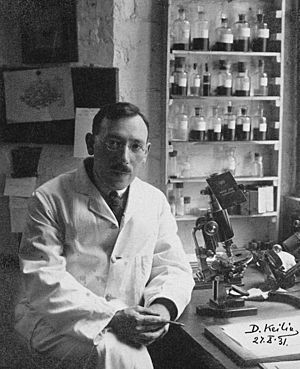David Keilin facts for kids
Quick facts for kids
David Keilin
|
|
|---|---|

David Keilin in 1931
|
|
| Born | 21 March 1887 |
| Died | 27 February 1963 (aged 75) |
| Alma mater | University of Liège Magdalene College, Cambridge |
| Known for | Cytochrome |
| Awards | Fellow of the Royal Society Royal Medal (1939) Copley Medal (1951) |
| Scientific career | |
| Fields | Entomology and parasitology |
| Institutions | University of Cambridge |
| Doctoral advisor | George Nuttall |
| Author abbrev. (botany) | |
David Keilin (born March 21, 1887 – died February 27, 1963) was a famous scientist. He was known for his work with insects and parasites. He also made a very important discovery about how living things use energy.
Contents
Early Life and Learning
David Keilin was born in Moscow in 1887. When he was young, his family moved to Warsaw. David had health problems, including asthma, so he did not start school until he was ten years old.
Even though he started late, he was a very bright student. At age 17, in 1904, he began studying at the University of Liège. Later, he continued his studies at Magdalene College, Cambridge in England. He eventually became a British citizen.
A Career in Science
In 1915, David Keilin started working at the University of Cambridge. He was a research assistant to George Nuttall, a professor of biology. Keilin spent his entire career at Cambridge.
He became a professor and director of the Molteno Institute in 1931. He worked there until he retired in 1962.
Studying Insects and Parasites
Keilin loved studying insects, which is called entomology. He also studied parasitology, which is about parasites. These are tiny living things that live on or inside other creatures.
He wrote many scientific papers about his findings. For example, he studied how lice reproduce. He also looked at the life cycle of the horse bot-fly. He even researched how fly larvae (baby flies) breathe.
The Discovery of Cytochrome
David Keilin is most famous for his work on something called cytochrome. This is a special protein found in almost all living things. It helps cells create energy.
A scientist named C. A. MacMunn first found cytochrome in 1884. But his discovery was not well understood or was forgotten. In the 1920s, Keilin rediscovered it and gave it the name "cytochrome." His research helped scientists understand how our bodies and other living things get energy.
Awards and Honors
David Keilin was a highly respected scientist. In 1926, he was chosen as a Fellow of the Royal Society. This is a very important group for scientists in the United Kingdom.
He received two major awards from the Royal Society:
- The Royal Medal in 1939
- The Copley Medal in 1951
These awards recognized his amazing contributions to science.
His Legacy
After David Keilin passed away, his work continued to inspire others. The Biochemical Society started the Keilin Memorial Lecture in 1964. This special lecture honors his memory. Scientists who give the lecture talk about topics that Keilin was interested in, like how cells make energy. They also receive a medal with his picture on it.

